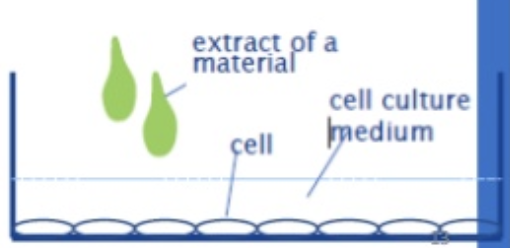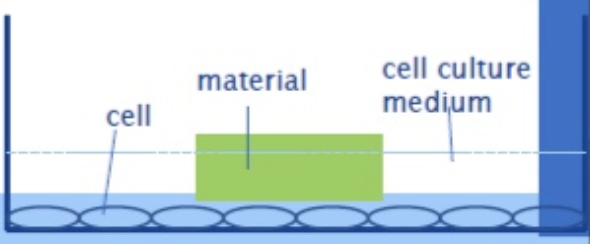Cytotoxicity testing is a sensitive method to assess the biocompatibility of a material extracted through a specific cell culture media following exposure of the extracted fluid to L929 cells. This test is performed on raw materials in the manufacturing process, all medical devices contacting patients, and devices undergoing a sterilization validation.
STEMart provides a wide range of in vitro cytotoxicity assays to qualitatively and quantitatively evaluate the ability of medical device to damage cells or tissues.
Qualitative Methods
- Extraction Method/ MEM Elution
In Minimum Essential Medium (MEM), extract the leachable of a medical device for 24 hours. An extract is then placed over the L929 cells. The cells are examined microscopically for morphological changes, degeneration, and lysis of the cells following incubation.

Fig. 1 Qualitative cytotoxicity test with MEM elution.
- Agar Diffusion/ Agarose Overlay Assay
In this method, a thin layer of nutrient-supplemented agar is placed over the L929 cells. The test material is placed on top of the agar layer, and the cells are incubated for 24 hours. Cytotoxic leachable diffuses into the cell layer via the agar layer, and a zone of malformed, degenerative, or lysed cells will be used to assess cytotoxicity.
- Direct Contact
The test material is placed directly onto cells growing on culture medium without the agar layer, cell cultures are grown to a standard monolayer, the cells are then incubated for 24 hours at 37 ℃. During the incubation, leachable chemicals in the test material can diffuse into the culture medium and contact the cell layer. Examining the monolayers for the presence of morphological changes, reduction in cell density, or lysis of cells to indicate the cytotoxicity.

Fig. 2 Qualitative cytotoxicity test with direct contact method.
Quantitative Methods
- MTT Assay
MTT assay is used often in determining cell viability (detects viable cells). The MTT can be used to evaluate the cytotoxicity of toxic compounds and toxins and environmental pollutants.
- Calcein Assay
The calcein-AM is used in the testing of cell viability as it can pass through the cellular membrane into live cells. After being transported into the cells, the acetomethoxy group is removed from intracellular esterases, the molecule gets trapped inside and gives out strong green fluorescence. Only live cells are labeled and counted by flow cytometry as dead cells lack active esterases.
- Neutral Red (NR) Assay
The neutral red (NR) assay is a cell survival chemosensitivity assay. This assay is based on the incorporation of NR into the lysosomes of viable cells after being incubated with test agents. When a reduced cytotoxic effect was determined by the NR-test, which shows the activity of lysosomal enzymes, microscopically multiplication or enlargement of lysosomes was observed.
- Lactate Dehydrogenase (LDH) Leakage Assay
Lactate dehydrogenase is a soluble cytosolic enzyme present in most eukaryotic cells, and it will release into culture medium upon cell death due to damage to the plasma membrane. The increase of the LDH activity in culture supernatant is proportional to the member of lysed cells. Subsequently, LDH activity can indicate cell membrane integrity and assess cytotoxicity resulting from chemical compounds or environmental toxic factors.
STEMart offers medical device cytotoxicity testing service to advance your medical device development and facilitate the manufacturers submitting their medical device for regulatory approval. If you have additional questions about cytotoxicity or would like to find out more about our services, please feel free to contact us.


